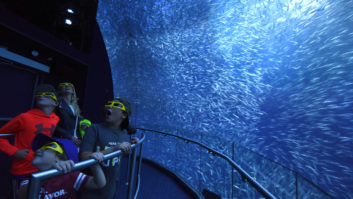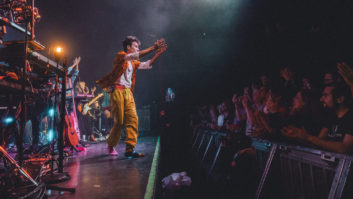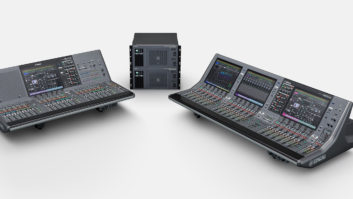Los Angeles, CA—For some, the first realization of Jacob Collier’s innate talent and musical prowess came with a split-screen video of him singing and performing every part on a radically rearranged cover of Stevie Wonder’s “Don’t You Worry ’Bout a Thing,” posted on YouTube in late 2013. He was 19 at the time. “Recorded entirely with one SM58 microphone,” says the video’s notes—and there’s no prize for guessing that he also created the video.
In the years since, Collier’s life has been a whirlwind: opening for Herbie Hancock and Chick Corea with his one-man show at the 2015 Montreux Jazz Festival at the behest of Quincy Jones; a debut album, In My Room, recorded and mixed in just three months in the music room at the family home in London (he won two Grammys); and numerous performances, collaborations and masterclasses worldwide. Late last year, Collier released Djesse (Vol. 1), the first of a four-volume, 45-song project, which he produced, arranged and orchestrated, and which features over two dozen collaborators from around the world. Volume 2 will be released in June 2019, with him returning to the road for dates in the Northwest. (Collier will talk about Djesse in the June issue of Pro Sound News.)
Related: Live Sound Showcase: Twenty One Pilots, by Steve Harvey, Jan. 2, 2019
To tour the new release, Collier has assembled a band that includes Maro, a Portuguese multi-instrumentalist, bass player Robin Mullarkey and drummer Christian Euman. Ben Bloomberg, who has been collaborating with Collier since helping him develop his one-man show, has further evolved the on-stage technology to suit the expanded lineup.
“On Jacob’s first tour, it was just the two of us,” says Bloomberg on the phone shortly after the U.S. leg of the tour ended in mid-March. “Then Jose [Ortega, FOH engineer] came on to do the shows that I couldn’t do. Now, the show and the tech has gotten big enough that I fill the role of production director and help them design the gear, choose the gear and program everything.” Claudio Somigli, another long-time collaborator, mixes monitors.

The first thing that Bloomberg and Collier worked on was the Harmonizer, which enables Collier to achieve his vocal layering live. “It’s sort of a cross between a vocoder and a live sampler, running a lot of custom software but also hardware. It’s got some dismantled parts from some other products that we liked,” Bloomberg reveals. “We thought 12 voices would be good; you can play two keys with your thumb, and Jacob’s favorite chord has all 12 notes in it.”
Bloomberg spends less time on the road now, he says, not least since he’s still a student in the Ph.D. program at MIT’s Media Lab. On previous shows, he’s used all kinds of desks, but on this leg, a bus-and-trailer tour, he suggested a pair of DiGiCo SD10s for the engineers. Previously, in Europe, they had SD12s.
“I’m a huge fan of DiGiCo, mainly because of the flexibility,” says Bloomberg. “Having the dual displays on the SD12 is really amazing for moving quickly during rehearsals, and adding and changing things. The SD10 was nice for the U.S. tour, because we had a few opening acts and we were able to use some of the additional DSP to accommodate those extra inputs very flexibly.”
Related: DiGiCo Dives Into Coachella, June 28, 2018
Indeed, flexibility is key across the board. “The goal is that the band can do whatever it wants. The crew has to be ready to react, and the DiGiCo certainly helps with that,” he says. “We focus on making the show feel organic and fluid.”
Collier uses a Shure Axient Digital wireless mic with a KSM9 capsule, with a second positioned at the piano. “The KSM9 is a great match for his voice, but he’s running around so much that we also have a DPA 4088 headset that he wears. We try to use the KSM as much as possible, but he comes down front or moves to another instrument, and we need to be ready to catch it as it happens.” Ortega programmed a macro on the desk that selects the active mic and mutes the other two, adds Bloomberg.
Because Collier’s performances are so freewheeling, Bloomberg designed a tech setup with no show automation, timecode or click tracks. It also had to be robust, transportable and easy to set up, especially with fly dates coming up later this year.
“We have a pair of identical laptops, running redundantly, that contain all the electronics for the entire performance; the entire show runs off a single laptop. That was for cost, but it means everything can be connected—all the keyboard sounds, drum samples, some of the stuff coming out of Jacob’s world, like the talkbox, and MIDI out of his piano. We did have to do some OS-level tweaks. Some of the newer Apple stuff is intended to go crazy with the power-saving, so we had to disable a lot of that stuff.”
Related: Live Sound Showcase: U2—Speaking from Experience, by Clive Young, June 22, 2018

The system features Apple MainStage and Ableton linked and running simultaneously. Collier has been working in Logic Pro since age 11. “We can take his Logic channel strips directly from the album, re-create those in MainStage, but automate it using some of the control and looping capabilities of Ableton,” says Bloomberg.
Maro, at her keyboard, controls the master patching. “She’s switching her own sounds, but she’s also enabling different signal paths, like sidechains and that kind of thing. Rob, Christian and Jacob all have their own sets of patches as well, but those are all being switched on the same laptop.” The musicians use a variety of Novation networked controllers. “We run MIDI around the stage, just like the mic lines; that’s built into the snakes,” says Bloomberg.
Want more stories like this? Subscribe to our newsletter and get it delivered right to your inbox.
The laptop outputs pass through a Focusrite Red 16Line interface and over a Dante network—the redundant secondary path travels via Dante Virtual Soundcard—into a RedNet D64R MADI-Dante Bridge and the DiGiCo desks. The mixers wrangle about 56 inputs, says Bloomberg. “We try to mix things down, partially because it makes the primary/backup switch easier, but we’ve got about 14 channels coming from the computer. And because we’re doing looping, we’re also sending to the computer. I haven’t seen a lot of people who are doing a completely redundant looping system as well as playback and keyboards.”
The benefit of towing a trailer is that the tour can carry some key items of gear, says Bloomberg, such as a totally Yamaha backline, including a MIDI-capable grand piano. “We were layering textures with the acoustic piano sound. It was nice to have the same instrument every day.”
Jacob Collier • www.jacobcollier.com






